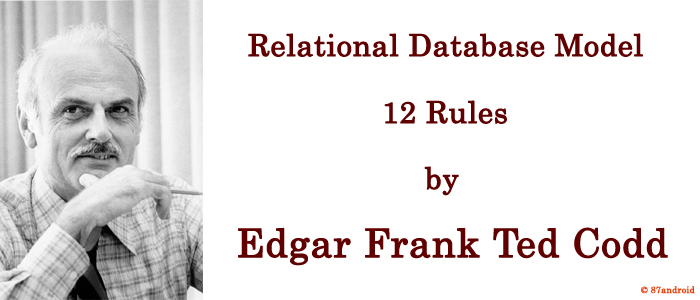Edgar Frank Ted Codd was the pioneer of the relational model for database management. This model represent the core model for relational databases. He mentioned the requirement for database management system to be considered as a “relational” in this core model(12 rules). However this model is widely accepted in the IT industry and remains a basic theoretical model for relational database management system.
In this model Dr. E.F Codd has defined 13 rules which starts from 0 and ended with 12, that’s why we referred it as a 12 rules by E.F Codd. Dr. Codd uses a basic idea of relational algebra(Maths) which breaks data into sets and related common subsets for relational database management system. Under the relational model, data is separated into the sets and resemble as a table structure which further consists of individual data elements such as columns or fields. In this article we are going to learn about 12 rules of Dr. Codd which provides the core theoretical approach for relational databases. But before going straight into the 12 rules, we must know about the relational databases.
What is Relational Databases
In simple words we can define relational databases as a collection of tables in which each table schema must identify a column or group of columns. In relational databases all tables are organized according to the relational model. Relational databases are both created and queried by Database Management Systems.
12 rules by Dr. Codd
Rule 0: This rule is known as the “Foundation Rule” of Dr. Codd 12 rules. This rules says that a relational database management system(RDBMS) must be able to manage database entirely through its relational capabilities. Database System must meet relational standard by using its relational abilities to manage database.
Rule 1: All information(including table and column names) in a relational database is represented explicitly as values in tables. We can define this rule as a “Informational Rule“.
Rule 2: This rule ensures guaranteed access to the every value in relational database. This rules states that all data must be accessible by a combination of the table name, primary key value and column name.
Rule 3: The database management system provides systematic support for the treatment for null values(unknown or empty values), distinct from default values and independent of any domain. In short this rule provides the systematic null value support to database.
Rule 4: This rules defines an active,online relational catalog, which means the description of the database and its contents is represented at the logical level as tables. It further can be queried by using the database language.
Rule 5: This rule states that at least one relational language must have a well defined syntax and be comprehensive. It must support Integrity rules, authorization, data definition, manipulation and transactions.
Rule 6: In this rule Dr Codd talk about Views. He stated that all views that are theoretically updatable can be updated through the system.
Rule 7: Rule 7 states that the system must support insert, update and delete operators. It should be supported for any retrievable set rather than just for a single row in a single table. In short this rules defines Set-level insertion, update and deletion.
Rule 8: This rule guarantees physical data independence as application programs and ad hoc programs are logically unaffected when physical access methods or storage structures are altered.
Rule 9: Logical data independence is the core of this rule. As this rule states that application programs and ad hoc programs are logically unaffected to the extent possible, when changes are made to the table structures.
Rule 10: This rule states that the database language must be capable of defining integrity rules. They must be stored in the online catalog and they cannot be bypassed. This rule supports integrity independence for databases.
Rule 11: The Distribution of application programs to various locations should be invisible to users of the database. Application programs and ad hoc requests are logically unaffected when data is first distributed or when it is redistributed. Distribution independency to databases is the core of this rule.
Rule 12: This is the last rule of Dr. Codd rules as this states non-subversion, which means that it must not be possible to bypass the integrity rules defined through the database language by using lower level languages.
Note: Many databases has “Parent-Child ” relationship. It means a parent node would contain file pointers to its children. Above mentioned rules are the basics of any relational database management system.
Uploaded by: Author


